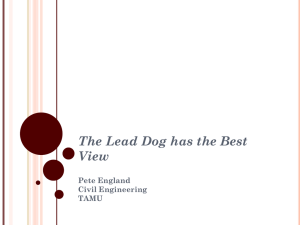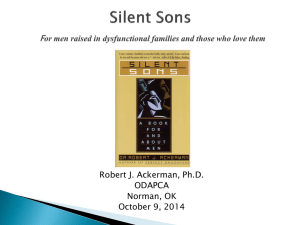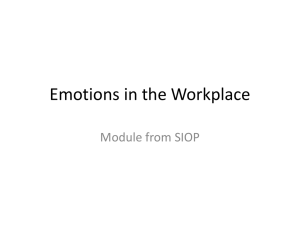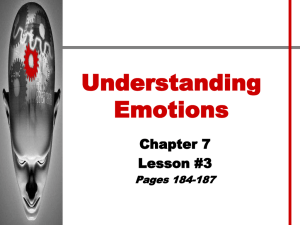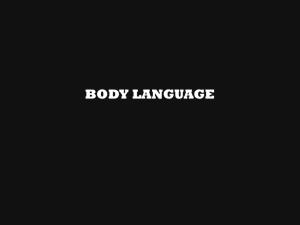Conflict Management and Resolution
advertisement
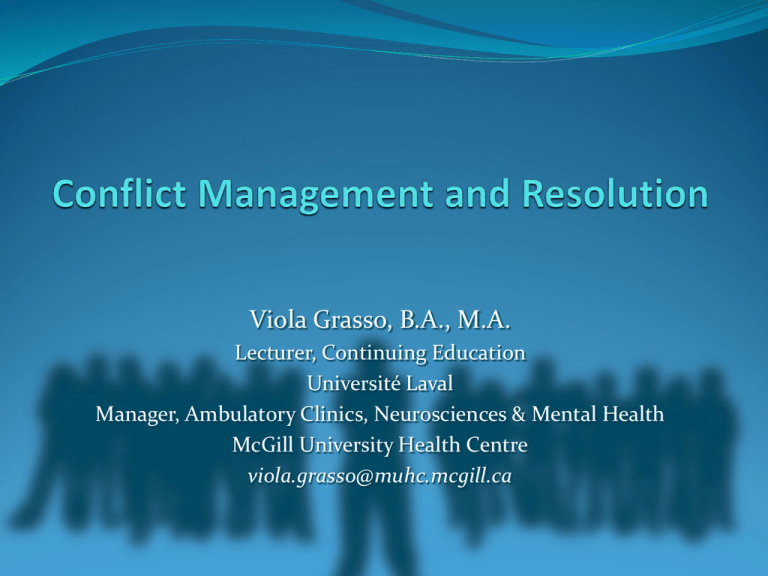
Viola Grasso, B.A., M.A. Lecturer, Continuing Education Université Laval Manager, Ambulatory Clinics, Neurosciences & Mental Health McGill University Health Centre viola.grasso@muhc.mcgill.ca Objectives Understanding Conflict Definition and Principles Why it Exists Knowledge on Styles and Tendencies Communicating with Different people Appreciation of Tools helpful in Managing Conflict Strategies for Conflict Resolution Develop Greater Capacity in Intervening and Dealing: With “Difficult” People Principles of Negotiation What is Conflict... For you! Talking about conflict.... Draw conflict! Write one word that summarizes conflict! FIGHT Definition Latin : « conflictus » Primary Sense : combat, fight, a clash, to come into opposition; Secondary: a state of opposition between ideas, interests, needs, etc.; A struggle or contest between people with opposing needs, ideas, beliefs, values, or goals A malaise or disagreement (expressed or not) Components Actors Protagonists, antagonists, opponents; Relationship Interdependence: Need of the other or its resources. (the greater the interdependence , the greater the risk of conflict) Proximity: The greater the interactions, the greater the risk of conflict Issue (X Factor) Dispute, problem(s), target around which we confront. Some Principles to Consider Negative Image! Perception is Key Conflict is inevitable therefore Difficult Conversations are inevitable Managing Self: Emotional ! Diplomatic grenades do not exist! Emotions are Signals Their intensity is a measure of the importance of the situation or issue They allow us to identify our triggers The importance of the relationship Intuition versus Strategy… Why Do Conflicts Exist? Lack of meaning and reference; Confusion, ambiguity, lack of information and communication, absence of meetings and exchanges; Roles and responsibilities are not clearly defined (boundaries between positions, tasks, people); Organizational changes (culture, values, processes, work methods, habits) thus: Change in comfort level, relationships between people, sense of belonging, loss of power); Unrealistic expectations Dionne et Miljours, 2001 Why Do Conflicts Exist? Favouritism, perceived preferential treatment; Disagreements over objectives to be achieved, conflicting interests for future direction, on the definition of a problem (s); Mergers of institutions, services (differences in values, cultures, management styles, ways of doing things, processes, relationships between people, level of influence, flexibility); Evaluation meeting, performance. Dionne et Miljours, 2001 Most Common Fundamental conflict: is a fundamental disagreement on the objectives to be pursued and the means to achieve it. Emotional conflict: is due to relationship problems that arise in particular by feelings of anger, mistrust, animosity, fear and resentment. Advantages and Disadvantages Constructive: Clarification of issues that would otherwise remain latent; Stimulates creativity conducive to performance improvement; Carrier of change and progress; Release for emotions and stress; A choice? Allows us to understand others’ needs Destructive: Diverts energy and may promote hostility; Polarizes groups and deepens differences; Effectiveness and efficiency of work may be affected; Relationships are broken; Unhealthy work environment (employees unmotivated, disengaged and ill). Observed Behaviours in Conflict 0% 10% 20% 30% 40% 50% 60% 70% 74% Passive Resistance Retention of Infos 69% 68% Creation of Clans 63% Systematic Critics 61% Withdrawal 55% Demeaning 53% Critical of Initiatives 48% Disinformation Neglect of Info’ Transmission 47% 40% Obstruction Verbal Aggression 80% 30% Three Underlying Themes - (messages) One cannot not communicate: ! Paul Watzlawick Circumstantial: Dialogue about a disagreement on what happened, or what should happen; Good or bad intention; who is right, who is wrong? The Story Emotional: Deliberation on emotions; Are my emotions acceptable, adequate? Should I recognize or deny? How do I react? Identity: • The internal debate to decide what the issues are; • Am I competent, responsible; worthy to talk about? • What does this say about me, about us? Marc Cardinal http://www.cba.org/abc/practicelinkfr/nationalarticles Who are we Communicating with? The Intuitive : Moves a lot; Roughly speaking ...; Outlines generally; Needs to: understand the why! The Pragmatic : • Precisely, exactly, etc..; • Feels lost in uncertainty; • Facts and details; • Needs to know: what and at what time and, then...etc.. Marc Cardinal http://www.cba.org/abc/practicelinkfr/nationalarticles Who are we Communicating with? The Introvert : He does not like long conversations; Go straight to the point;; Need to control: get him to decide, let him feel that he is the one who will make the decision. The Extravert: He needs you to be energized, likes to be with others; He thinks aloud; Need to talk: multiply the opportunities for him. Marc Cardinal http://www.cba.org/abc/practicelinkfr/nationalarticles Who are we Communicating with? The Rational : Look right into the eyes; Be consistent in your explanations; Go point by point. Need for logic: set specific deadlines and stick to them! Marc Cardinal http://www.cba.org/abc/practicelinkfr/nationalarticles Listening Profiles FACTS (THINKERS) EMOTIONS (FEELERS) RELATIONSHIPS (FEELERS) RULES (THINKERS) Facts Descriptions Statistics Data Proof Rational Arguments Where, when, how Emotions Sentiments Climate Reactions Emotional charge Sensitive to effects of arguments... What happens between people Harmony Work Climate Network Who is talking with whom (gossip Rules Procedures Standards Principles Ways of doing doing things... Laws Habits Custom ‘This is the way it happened..’ Studies show that... ‘That does not make sense ‘When?’ ‘When do you want that for?’ ‘There were people everywhere watching...’ ‘I knew this guy..’ ‘We had a meeting and we think...’ ‘There was a stop and he missed it! ‘We must, we have to..’ ‘Usually’ ‘We have always done that19 this way... It Starts with You! Attitudes and Tendencies: authoritative, magical thinking, finding solutions, avoidance Manage yourself before managing others; Emotions; Uncertainty, Ambiguity and Paradoxes: Values, Interests, Needs; Your culture and that of your organization; Informal structures in place. Abilities and Competencies; Role et Responsibilities: What is your level of informal and formal power? Guérard G. 2008 Conflict Styles Who are You in Conflict? Thomas and Kilmann (1974) The Different Profiles Competing (Using Power to resolve a conflict: Want to win!) Collaborating (Understanding other and Using Communication) •The strong leader •The autocrat •The activist •The bully •The democrat •The relationship builder •The subversive •The procrastinator Avoiding (Withdrawing from the relationship, pretending there is no conflict) Accommodating (Giving in to avoid conflict) •The strategist •The avoider, the shadow •The good natured •The doormat Guérard G. 2008 What is your style? Competing Taking a firm position In position of power (role, rank, expertise, and capacity of persuasion) Useful: When the Issue is Important In emergency situations; When making unpopular decisions; A method in dealing with irony and sarcasm Collaboration Meets the needs of all persons involved There is time Good faith and trust Useful: When both the issue and the relationship are important Gather a range of views to obtain the best solution When the situation is too important for a simple compromise Thomas and Kilmann (1974) What is your style? Avoiding Delegation of controversial decisions When accepting default decisions Not wanting to hurt anyone May be appropriate when victory is impossible Useful: Controversy is trivial Someone else is in a better position to solve the problem Allow others to find a solution Accommodating Compromise is possible Creates a spirit of conciliation Favour the other to the detriment of your own benefits Useful: When the relationship is important Preserve harmony Thomas and Kilmann (1974) What is your style? Compromising: (concession) Everyone is willing to compromise; Creates a spirit of conciliation Useful: When the cost of conflict is higher than the cost of losing ground; Opponents are evenly matched; When there is an imminent deadline. Thomas and Kilmann (1974) Some Thoughts... Is the style you use appropriate in this situation? Are there styles that I use little? How important is the issue? (for me and team and for the other and his team)? How important is the relationship? (for me or other) How much time and energy do I want (or can I) put into this situation? What do I have to lose if I do not act in this situation? Guérard (2008) How do we manage our own emotions? Step 1: Observe your emotions (how you feel, internal discourse) and how they reveal themselves (manifestations and signs); Step 2: Identify the triggers of your emotions; (events and people; historical context, facts and assumptions) Step 3: Identify the causes (issues) of these emotions. (values, competency, relationship, survival) Guérard (2008) An example! How to say no, without saying no.... You are faced with a loud, extraverted, unhappy parent, who is complaining about how we have treated her son; his marks are below average; he has not respected the registration deadline for admission into the program; the emotional charge is high; mom accuses you of ‘not doing your job’, for her son is ‘bright and deserves to be in college’; she says that your decision ‘does not make sense’ and you will be ‘responsible for her son’s future’ A Few Strategies! Let mom vent; Do not interrupt.. Get your emotions under control; Do not say no, yes sort of.....restate the other’s comments, present your point of view and ask for her version or a reaction to your view; Focus on the issue not the person; Mimic her style; Express how you feel; be specific and stop. Explain the reasons by describing the situation again; Give mom choices; Specify what you can do and what her options are IFUW (2001) Communication Tips and Strategies (Active Listening) Encourage: Tell me more? I want to know what you think? Clarify: When did that happen? How did you feel? What did you do? Paraphrase: So I understand that you wish your opinion to be heard. Repeat what you heard Shepell-fgi, 2010 Communication Tips and Strategies (Active Listening) Reflect: You seem to be upset by the situation. You seem to feel strongly about that. Summarize: It seems that these are important issues. What I heard was… Validate: I am sensitive to your wish to resolve this matter. I respect your view, your feelings… Shepell-fgi, 2010 Nature of Conflicts Types Possible Intervention Perception: Different representation of the same reality Needs: • Dialogue, cropping (rephrase) • Suggest new reality • Open Questions • Facts Interests • • Share conventions, rules; Adhesion: a common and shared needs Beliefs, Priniciples • • • ‘I’ Create Code of Conduct; Share organizational values Information • • Manage expectations; Provide a sense of why and vision Structural • Clarify the interpretation of roles, responsibilities and tasks; Coaching Values Operating Mode (Ways of working) • What Happened? What are you Feeling? When faced with an Emotional Charge What is most Difficult for you (right now)? What can Help you face this? Empathy Schreiber (2007) OBEFA Model (stating your issue) Open Statement: I have a problem (issue) Behaviour: When you do ‘x’ Effect: The consequences are ‘y’ Feelings: This makes me feel ‘z’ Action: I would like us to resolve this problem together (U of T - Dealing with Conflict; 2011) Strategies when faced with « Attitudes » Off topic Conversations: Request relevance; Stop the conversation and mention that it is irrelevant at this time The Negative person, antagonistic, hostile: I heard,,, paraphrase Ask for their opinion, what would you do? Attacks, criticises and argumentative: Describe without judgment what the person is doing The Absent: Disciplinary The Hidden agenda Question the relevance of the topic provided; Ask what he wants to do with his point; Limit airtime Thank the person and move on to the next topic Phases of Conflict : When do we intervene? BEFORE (LATENCY) Resides in people's perceptions ; potentially frustrating for their interests; Tension, dissatisfaction, frustration, problems, disagreements, mistrust, rumours DURING (CRISIS) Affects emotions ; conflict is deeply felt by individuals; Attributed malicious intent Intentions become convictions Positions crystallize Hate speech, harassment AFTER (OUTBURST) The conflict occurs and is observed in increased tension, anxiety, mistrust, aggressive remarks; Why there is conflict, is not important; What is important is who will win! Priniciples of Negotiation Make an objective assessment of the situation Stick to objective elements, the FACTS Limit use of personal examples One thing at a time (issue not the person) Move from uncertainty to curiosity Do what you say you are the example! Evacuate the emotional aspects Let the storm pass Look to the future Listen to your internal discourse Priniciples of Negotiation Be Open to the arguments and visions of the other: Do not enter into the content and emotions! Do not interpret as personal attacks (recognize signs of fear, anger, lack of confidence, inability or feelings of...) You are in your role, your status Take the lead, but share information judiciously! Concentrate on what is happening in your head and in your heart(what are you thinking , what emotions are you experiencing?) Do not dramatize Slow down, know when to stop! Control your reactions, put your subjectivity behind you Take a step back Traps to avoid! Just go with it!! Guessing the other, think the other is in bad faith; Feel guilty but bet on shared responsibilities; Ignoring your Emotions; Judgments Interpretations Generalizations Peremptory solutions Ingredients for a Healthy Environment? Policies and procedures of professional conduct (attendance, code of ethics); Establish Strategies, Clarify rules. Philosophy: Conflict is normal and even useful; No judgments; Conflicts should be addressed; Involvement and collaboration with levels of the organization; Teams or people identified crisis management (avoid isolation): Crisis or Tactical Team Mediation Thank you



